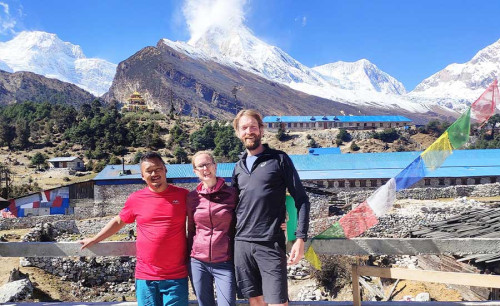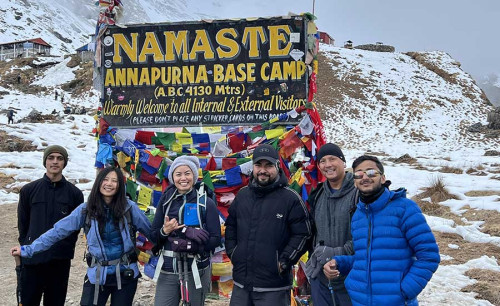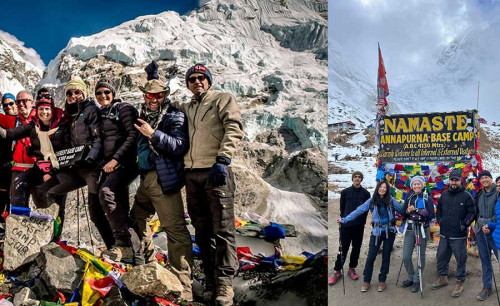Where is Nepal Located on Map?
Published On : 20th Oct, 2024 By Himalayan Dream Team

Where is Nepal Located: A Full Guide into Its Geography, History, and More Nepal is a landlocked country in South Asia, set in the central Himalayas between India (south/east/west) and China/Tibet (north). On the world map it sits near 28.39° N, 84.12° E. Its terrain rises from the Terai plains through mid-hills to the high Himalaya—about 68% of the land is hills and mountains—across 147,516 km². Nepal was never colonized and today is a diverse federal republic with 120+ ethnic groups and multiple faiths (Hindu majority, significant Buddhist and Muslim communities). The country includes eight of the world’s ten highest peaks, with trekking icons like Everest Base Camp.
At the heart of the majestic Himalayas lies Nepal-a culturally and historically rich country with a flair for natural beauty. Whether your curiosity pertains to its Asian location or its simple cultural heritage, this guide examines Nepal's geography and answers frequently asked questions.
Where is Nepal Located in Asia?

It lies in South Asia, bounded by India on the south, east, and west, and by China (Tibet Autonomous Region) on the north. The landlocked country follows in a long shape over the central Himalayan range, comprising varied topography that ranges from flat lowlands to towering Himalayan peaks. This is what makes it a popular destination among mountaineers and trekkers.
Where is Nepal Located in the World?

Globally, Nepal is situated in the northern hemisphere, about 28.3949° N latitude and 84.1240° E longitude. It is located on the Asian continent, sandwiched between the two giant nations of India and China. It is best known for being home to Mount Everest, the tallest mountain in the world.
Where is Nepal Located from India?
It shares approximately 1,690 kilometers of border with India. Nepal borders Indian states to the north, among them Sikkim, West Bengal, Bihar, Uttar Pradesh, and Uttarakhand. Its open border policy allows free movement across the border, meaning close economic and cultural ties.
Is Nepal Part of India?
No, Nepal is not part of India. Although these countries may share cultural, historical, and economic ties with each other, it is an independent country with its government and constitution, like any other country in this world, and has full country identity. Nepal has always been an independent country and has never been colonized.
Where is Nepal Located on the Map?

On the map, Nepal is located within the central part of the Himalayan range. The country is bounded by India on one side and China on the other, its northern boundary touching the Tibetan Plateau; toward the south, the plains extend right up to the Indian border. Nepal's unique landscape features a mix of high mountains, rolling hills, and fertile lowlands.
How Much Land Area of Nepal is Covered by the Hilly Region?

About 68% of Nepal's land comprises hills and mountains, a broad tract of lower and mid-hill areas known as the Mahabharat Range, and the towering peaks of the Great Himalayas. Most of Nepal's rural population is found in the hilly districts, with a landscape of terraced farmlands, forests, and rivers.
What is the Total Area of Nepal?

The total area of Nepal is 147,516 square kilometres (56,956 square miles). Although the country is very small in size, Nepal's geography includes flat plains of the Terai, hilly midlands, and towering peaks of the Himalayas. Its terrain makes this country one of the most geographically diverse nations in the world.
Total Area of Nepal
| Geography of Nepal | Details |
|---|---|
| Continent | Asia |
| Area | Ranked 93rd |
| Total | 147,516 km2 (56,956 sq mi) |
| Land | 92.94% |
| Water | 7.06% |
History of Nepal: From Kings to a Democratic Republic
History of Nepal: A Journey from Kingdoms to Republic
Records of Nepal's history date back several thousand years, depicting various dynasties that have inhabited the place. Ancient Nepal was a land of small kingdoms, each headed by a different tribal leader. These early inhabitants created the rich cultural fabric of Nepal through their respective contributions, founding roots that were to set the base for a society steeped in religious and spiritual practices, notably Hinduism and Buddhism, which continue to mold its identity to this day.
King Prithvi Narayan Shah unified the small kingdoms into one sovereign state in 1768, which is considered the beginning of modern Nepal. This conquest of his, hitherto divided into a number of small rulers in the Kathmandu Valley, marked the route to building up one nation under the Gorkha Kingdom. Under the leadership of Shah, the country expanded its borders and strengthened its national identity to become a strategically positioned kingdom in the Himalayas.
For centuries, the land of Nepal remained under the rule of the monarchy, headed by the Shah dynasty. However, in 2008, after many years of political turmoil and a decade-long civil war, Nepal witnessed the dissolution of the monarchy, as the country transformed into a federal democratic republic. Its abolition heralded a new chapter in Nepal's history by ushering in democratic institutions. The Nepalese culture historically has had a close rapport with Hinduism and Buddhism, and both these religions constitute the backbone of the traditions, festivals, and way of life in Nepal.
Map of Nepal: A Closer Look

Glance at the map of Nepal, and you'll be aware that the country is mainly divided into three primary regions: the Terai, or lowland plains; the Hills; and the Mountains. On the other hand, a recent division consisting of seven provinces has been made, with each having its unique cultural and geographical identity. The most commanding feature on Nepal's map is the Himalayan range, consisting of eight of the world's ten highest peaks.
Do Nepalese People belong to India?
No, Nepali people are not Indians. This nation is a home to more than 120 ethnic groups. The people speak various languages across the nation. In fact, there are a lot of cultural similarities that can be traced, especially in the border areas; however, Nepali people take pride in their independent heritage.
Are Nepal People Muslim?
The majority in Nepali are Hindus, followed by Buddhists. However, there is also a small but significant minority of Muslims, about 4.4% of the people. There is religious tolerance and diversity in Nepal: Hinduism, Buddhism, Islam, and Christianity are practiced within its borders.
Religions in Nepal
| Religion | Percentage of Population |
|---|---|
| Hinduism | 81.3% |
| Buddhism | 9.0% |
| Islam | 4.4% |
| Kirat | 3.0% |
| Christianity | 1.4% |
| Others | 0.9% |
Are Nepal and India Friends?
Yes, the relations between Nepal and India are very close, as both share deep historical, cultural, and economic ties. It was agreed upon between the two governments that an open border between both countries should be allowed, enabling the easy facilitation of movements of people and goods in either direction. While political differences arise at times, Nepal and India remain closely tied in friendship and cooperation.
What Does Nepal Export the Most?
Textiles, carpets, handicrafts, and articles of pashmina are major exports of Nepal. The country is also known for exports of tea, coffee, and medicinal herbs. Although agriculture remains an important part of the Nepalese economy, most of these items are produced by small-scale farmers in its countryside.
What is Nepal's Currency?
The Nepalese Rupee or NPR is the official currency in Nepal. One Nepalese rupee is subdivided into 100 paisa. The Nepalese rupee is pegged to the Indian rupee, a factor that makes transactions and travel between these countries quite easy.
Exchange Rate of Foreign Currencies for Nepali Rupees (As of 20/10/2024)
| Currency | Code | Exchange Rate (NPR) |
|---|---|---|
| US Dollar | USD | 135.50 |
| Euro | EUR | 143.80 |
| British Pound | GBP | 165.20 |
| Australian Dollar | AUD | 87.90 |
| Canadian Dollar | CAD | 100.30 |
| Japanese Yen | JPY | 0.90 |
| Chinese Yuan | CNY | 18.80 |
| Indian Rupee | INR | 1.60 |
What is Nepal's Language?
Nepali is the official language spoken by the majority of people in Nepal. However, over 120 languages spoken in the country show how ethnically and culturally diverse it is. Other major languages spoken in the country are Maithili, Bhojpuri, Tamang, and Newari.
Major Languages of Nepal
| Language | Percentage of Population | Region Spoken |
|---|---|---|
| Nepali | 44.6% | Nationwide (Official Language) |
| Maithili | 11.7% | Eastern Terai (Provinces 1, 2) |
| Bhojpuri | 5.8% | Central and Eastern Terai |
| Tharu | 5.1% | Western Terai |
| Tamang | 5.1% | Hilly Region (Central Nepal) |
| Newari | 3.2% | Kathmandu Valley |
| Magar | 2.97% | Western Hills |
| Awadhi | 2.47% | Western Terai |
When Did Nepal Get Independence?
To this date, Nepal is the only country in the world that was never colonized. The Nepalese government remained totally sovereign during the whole course of its history and even during the British colonial era in South Asia. It does not have an official "Independence Day."
When Was Nepal Founded?

The small kingdoms were unified under the rule of one king, King Prithvi Narayan Shah, in 1768 by the unification of the Kathmandu Valley. This is also referred to as the beginning of the Shah Dynasty. A Shah ruled over Nepal until 2008 when it became a republic.
Why is Nepal's Flag Different?

The flag of Nepal is the only flag in the world that is not rectangular. It consists of two triangles piled on each other, symbolizing the Himalayas and representing the country's two major religions: Hinduism and Buddhism. The sun and moon on the flag represent the hope of Nepal to live long.
Popular Trekking in Nepal
Nepal boasts some of the most amazing trek routes in the world, extremely popular with visitors coming from far and wide. Be it a moderately paced trek that one wants to undertake with breathtaking views or an expeditionary challenge - Nepal has it all. Some unmissable trekking destinations:
1. Annapurna Base Camp Trek

The Annapurna Base Camp Trek is one of Nepal's most in-demand treks and falls right in the middle in terms of difficulty, with extremely rewarding vistas. It takes you through quaint villages, lush rhododendron forests, and terraced farmlands. You will view a 360-degree display of the towering peaks at the nearing vicinity of Annapurna Base Camp, Annapurna I, Machapuchare, and Hiunchuli. This trek is ideal for those who want to feel the majesty of the Himalayas without pressing into high-altitude extremes.
2. Annapurna Circuit Trek

These include varied landscapes comprising of subtropical forests and paddy fields to arid highland and alpine meadows. The Annapurna Circuit Trek rounds the whole Annapurna massif, crossing the Thorong La Pass at 5,416 meters, with a rewarding vista of Annapurna and Dhaulagiri. There's also a possibility for trekkers to go through varied cultures of Gurung and Thakali communities. Variety and challenges make this one of the most popular treks among adventurers.
3. Ghorepani Poonhill Trek

The Ghorepani Poonhill Trek is an ideal trek for those who wish to have a shorter, easier trek with tremendous views. The trek passes through the rhododendron forests and beautiful villages onto Poon Hill for a panorama of sunrise over the ranges of Annapurna and Dhaulagiri. For beginners or families, this is a well-liked option that presents great rewards without the technical demands of high-altitude trekking.
4. Everest Base Camp Trek

The Everest Base Camp Trek has become synonymous with a Himalayan adventure, which is what this route takes one through to the heart of the Khumbu and on to the foot of the tallest mountain in the world, Mount Everest. En route, the trek passes Sherpa villages, crosses suspension bridges over raging rivers, and affords close-up views of Everest, Lhotse, and Nuptse. The trek reaches its climax at Everest Base Camp, where one stands right at the foot of this fabled peak-a lifetime experience for trekkers all over the world.
5. Manaslu Circuit Trek

The Manaslu Circuit Trek takes you to a remoteness that few of the more famous treks-such as the Annapurna ones-offer. The path circumnavigates mighty Manaslu, the eighth highest mountain on Earth. Pristine landscapes, dramatic ridges, and engagement with traditional Tibetan culture are just some of the attractions of this trek. One of the most prized components of this trek is the crossing of Larkya La Pass at 5,106 meters over a challenging path for stunning panoramic views of surrounding peaks.
6. Kanchenjunga Circuit Trek

The Kanchenjunga Circuit Trek is an adventurous and remote trekking route around the third highest mountain in the world, Mount Kanchenjunga. This might be an ideal trek for experienced trekkers seeking solitude and pristine wilderness. It offers a variety of diverse landscapes that range from lush forests up to high-altitude alpine zones with dramatic views of Kanchenjunga and its surrounding peaks. The remoteness of this trek makes it a true wilderness adventure.
7. Everest Base Camp Trek with Helicopter Return

The Everest Base Camp Trek with Helicopter Return provides all of the thrills of the traditional Everest Base Camp trek but adds in the luxury of a helicopter flight back to Lukla. Ideal for trekkers looking to experience the adventure of reaching Everest Base Camp without the tiring journey of returning on foot. The helicopter ride offers unparalleled views of the Himalayas while providing the trekkers with an Everest beauty from above, besides along the ground.
8. Upper Mustang Trek

The Upper Mustang Trek to the ancient Kingdom of Mustang starts through this restricted area, continual landscapes of the Tibetan Plateau. A really magical adventure in the wind-blown valleys, ancient caves, and monasteries of this country so bathed with Tibetan-influenced culture. Its remoteness and preservation of traditional Tibetan Buddhist culture make it one of the more fascinating areas for trekkers in search of something different.
9. Langtang Valley Trek

Langtang Valley Trek is a moderate trek that goes through a beautiful Langtang Valley offering magnificent close-up views of Langtang Lirung, and other snow-capped peaks. This trek is famous for its rich flora and fauna, with dense forests and Langtang National Park home to the rare animals like the red panda. This actually passes by a traditional Tamang village for the trekker to feel the culture and hospitality of the people, making it both a culturally enriching as well as a scenic journey.
Conclusion

Nepal is small, yet fascinating-a country with rich cultural heritage and a geography that is simply dazzling. Its unique location between India and China, diverse population, and historical significance make it one of the must-see countries in the world. Whether exploring the history of its kings, its map, or its modern identity, Nepal stands out truly as a land like no other.
Recent Posts

2nd Dec, 2025

24th Nov, 2025

21st Nov, 2025

10th Nov, 2025

9th Nov, 2025

25th Oct, 2025

22nd Oct, 2025

17th Oct, 2025

17th Oct, 2025

13th Oct, 2025





